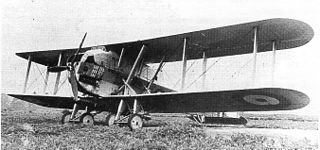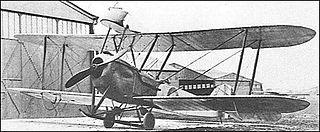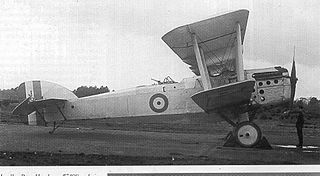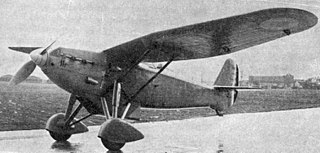Development and design
In 1924, H.G. Hawker Engineering made a proposal to the British Air Ministry to build a new single-seat fighter powered by the Rolls-Royce Condor engine. As a result, the Air Ministry placed an order for a single prototype, drawing up Specification 7/24 to cover the aircraft. Many of the normal requirements included in fighter specifications were omitted with the hope of resulting in an aircraft with higher performance. The specification required a speed of 208 mph (335 km/h) at sea level and a service ceiling of 29,000 ft (8,800 m), with an armament of a single machine gun. The new design, named the Hawker Hornbill, was produced under the supervision of Hawker's Chief Designer W. G. Carter, shortly before he resigned and was replaced in his role by Sydney Camm. [a]
The Hornbill was a single-bay biplane of mixed metal and wood construction. The front fuselage structure and engine mount was made of steel tube, and was covered with duralumin cladding, while the fuselage from the cockpit rearwards had a wooden structure with fabric covering. The wings had spruce spars and ribs and were also covered in fabric. The water-cooled Rolls-Royce Condor engine was tightly coweled to minimise drag, and drove a two bladed propeller (initially a fine-pitch Watts). The engine was cooled by a pair of semi-circular radiators beneath the lower wings. The pilot sat in an open cockpit behind the engine and fuel and oil tanks, with a cut-out in the upper wing trailing edge to improve his view. A single Vickers machine gun could be mounted low on the port side of the fuselage.
Testing
The prototype, powered by a 650 hp (480 kW) Condor III engine, made its first flight in the summer of 1925 with F. P. Raynham at the controls, probably early in July that year. [b] The Condor III engine was not compatible with Synchronization gear so the gun was not fitted. Test pilot duties soon passed to George Bulman, who reported that performance was disappointing. As a result, the propeller was replaced by a coarser-pitch metal Fairey-Reed propeller, but this had little effect. Another problem was that the engine suffered from over-cooling, with part of the radiators blanked off as a result.
In February 1926, the Hornbill was returned to Hawker's works at Kingston-on-Thames for modifications to be made. The engine was replaced by a 698 hp (520 kW) Condor IV fitted under a modified, longer, cowling, while the two radiators were replaced by a single semicircular radiator under the fuselage, and the fin and rudder were modified, giving a slightly larger area. The modified prototype returned to flight in May 1926, and was displayed at the RAF Display at Hendon Aerodrome in July that year. The aircraft was then sent to RAF Martlesham Heath for testing and service trials. While the aircraft was much faster than the contemporary Armstrong-Whitworth Siskin at low altitudes, performance dropped off above 15,000 ft (4,600 m) and the aircraft's ceiling was well below the 29,000 ft (8,800 m) required by the specification. Handling at high speeds was poor, with the aircraft lacking stability. At 150 mph (240 km/h) or above, steep turns could not be made without applying full rudder. Engine overheating occurred during flight tests, which may have been a result of using normal service fuel for extended high power runs. The cockpit was extremely cramped, with it not being possible for the pilot to reach the machine gun's cocking handle or the aircraft's compass or map case, while escape from the cockpit by parachute was considered to be difficult. The type was considered to be unsuitable for use as an interceptor, with Hugh Trenchard, the Chief of the Air Staff claiming that "...for war it would be practically useless".
The Air Ministry transferred the prototype Hornbill to the Royal Aircraft Establishment, where it was used as a testbed, being fitted with leading-edge slats on the upper wing, and undergoing extensive evaluation of its stability at and below the aircraft's stall speed. The aircraft completed its final trials in November 1932, and flew for the last time on 18 May 1933.

The Hawker Tempest is a British fighter aircraft that was primarily used by the Royal Air Force (RAF) in the Second World War. The Tempest, originally known as the Typhoon II, was an improved derivative of the Hawker Typhoon, intended to address the Typhoon's unexpected deterioration in performance at high altitude by replacing its wing with a thinner laminar flow design. Since it had diverged considerably from the Typhoon, it was renamed Tempest. The Tempest emerged as one of the most powerful fighters of World War II and at low altitude was the fastest single-engine propeller-driven aircraft of the war.

The Fairey Fox was a British light bomber and fighter biplane of the 1920s and 1930s. It was originally produced in Britain for the RAF, but continued in production and use in Belgium long after it was retired in Britain.

The Hawker Hart is a British two-seater biplane light bomber aircraft that saw service with the Royal Air Force (RAF). It was designed during the 1920s by Sydney Camm and manufactured by Hawker Aircraft. The Hart was a prominent British aircraft in the inter-war period, but was obsolete and already side-lined for newer monoplane aircraft designs by the start of the Second World War, playing only minor roles in the conflict before being retired.

The Hawker Fury is a British biplane fighter aircraft used by the Royal Air Force in the 1930s. It was a fast, agile aircraft, and the first interceptor in RAF service faster than 200 mph (320 km/h) in level flight. It was the fighter counterpart to the Hawker Hart light bomber.

The Hawker Nimrod is a British carrier-based single-engine, single-seat biplane fighter aircraft built in the early 1930s by Hawker Aircraft.

The Hawker Tornado was a British single-seat fighter aircraft design of the Second World War for the Royal Air Force as a replacement for the Hawker Hurricane. The planned production of Tornados was cancelled after the engine it was designed to use, the Rolls-Royce Vulture, proved unreliable in service. A parallel airframe that used the Napier Sabre engine continued into production as the Hawker Typhoon.

The Hawker Horsley was a British single-engined biplane bomber of the 1920s. It was the last all-wooden aircraft built by Hawker Aircraft, and served as a medium day bomber and torpedo bomber with Britain's Royal Air Force between 1926 and 1935, as well as the navies of Greece and Denmark.

The Avro 549 Aldershot was a British single-engined heavy bomber aircraft built by Avro.

The Fairey Firefly IIM was a British fighter of the 1930s. It was a single-seat, single-engine biplane of all-metal construction. Built by Fairey Aviation Company Limited, it served principally with the Belgian Air Force throughout the 1930s until the outbreak of World War II.

The Gloster F.5/34 was a British fighter of the 1930s. It was a single-seat, single-engine monoplane of all-metal cantilever construction; the undercarriage was of the tailwheel type with retractable main wheels.

The Blackburn T.4 Cubaroo was a British prototype biplane torpedo bomber of the 1920s. Built by Blackburn Aircraft and intended to carry a large 21 in (533 mm) torpedo, the Cubaroo was claimed to be the largest single-engined aircraft in the world at the time of its first flight.
The Hawker P.V.3 was a British single-engined biplane fighter prototype of the 1930s. Only a single example was built, the Gloster Gladiator being selected instead to fulfill the requirement to which it was designed.

The Blackburn 2F.1 Nautilus was a British single-engine two-seat biplane spotter/fighter built in 1929. Only one was completed.

The Westland Wizard was Westland Aircraft's first attempt to produce a monoplane fighter. The project was privately funded and the prototype design was done in the spare time of the company's engineers. This all happened during 1926, with high-speed performance as the primary goal.

The Beardmore W.B.XXVI (W.B.26) was a prototype British two-seat fighter of the 1920s. A single engined biplane, one example was built and evaluated by Latvia, but was not accepted for service.

The Westland F.7/30 was a British fighter prototype. A single prototype was built in 1934, but the type was not put in production because its performance fell far below the RAF's requirements. The Gloster Gladiator won the F.7/30 competition.

The Vickers F.B.11 was a prototype British three-seat escort fighter of the First World War. A large single-engined biplane, it carried one gunner in a nacelle mounted on the upper wing to give an allround field of fire. Only a single example was completed.

The Handley Page Handcross was a single-engined biplane day bomber built to an Air Ministry specification. It was not put into production and only the three prototypes were built.

The Parnall Pipit was a single-engined, single-seat naval fighter designed to an Air Ministry specification in 1927. Two prototypes were built but both were destroyed by tail flutter.

The ANF Les Mureaux 170 was a prototype French fighter aircraft of the 1930s. It was a single-engined, single-seat parasol monoplane, but only two were built, the type being rejected for service by the French Air Force.
This page is based on this
Wikipedia article Text is available under the
CC BY-SA 4.0 license; additional terms may apply.
Images, videos and audio are available under their respective licenses.




















